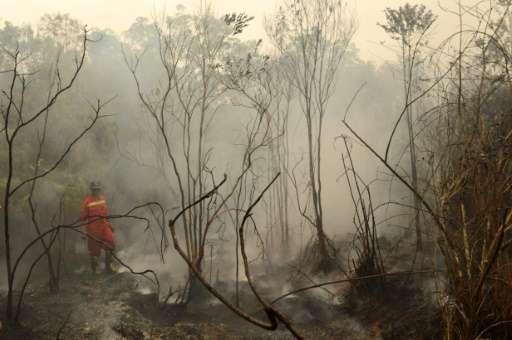Southeast Asia's haze: what's behind the annual outbreaks?

Southeast Asia has been enveloped in choking haze from agricultural fires in Indonesia in recent weeks, prompting flight cancellations and school closures, and causing diplomatic tensions to flare.
Singapore on Friday slammed "shocking" statements from Indonesian officials who made light of the crisis.
The haze is a regular occurrence, with the region wheezing through outbreaks every year during the dry season. Here are some questions and answers about what causes the outbreaks and why they keep happening.
Why do the outbreaks happen and when did they start?
The main cause is illegal fires started in peatland and forest on Indonesia's Sumatra island and the Indonesian part of Borneo, to quickly and cheaply clear land for palm oil and pulp and paper plantations.
They increased in number as plantations expanded, in particular due to rising global demand for palm oil, a key ingredient in everyday goods such as shampoo and biscuits.
The outbreaks started in 1997, with what is still regarded as the most serious haze on record. It followed rapid expansion of plantations in the preceding years, and coincided with an El Nino weather system that made conditions drier than usual in Indonesia.
Who is affected by the haze?
The haze has a devastating impact on daily life every year on Sumatra and the Indonesian part of Borneo. This year, air quality has hit hazardous levels, tens of thousands have contracted respiratory illnesses, many flights have been cancelled and schools closed.
From Indonesia, the smog is blown over Southeast Asia, and fouls the air in neighbouring Singapore and Malaysia.
On Friday, Singapore suffered its worst episode since mid-2013, with the city-state's air pollution index hitting hazardous levels, prompting officials to close all schools and distribute protective face masks.
Schools in the Malaysian capital Kuala Lumpur and nearby states were also forced to close last week due to the haze.
How bad is it this year?
It still has not reached the levels of the 2013 outbreak, when air quality deteriorated to the worst level for years in Singapore and Malaysia.
But it is serious and shows little sign of slowing down, with the situation exacerbated by the El Nino weather system that has made conditions tinder-dry, and Indonesian officials saying it may take weeks to bring the blazes under control.
More than 2,300 fire "hotspots"—either areas already on fire or very hot and likely to soon go up in flames—were detected by satellites on Sumatra and Indonesian Borneo Thursday.
Why is Singapore angry at Indonesia?
Singapore is annoyed that the outbreaks continue occurring and it accuses Indonesia of not doing enough to stop them. As haze levels soared Friday, tempers frayed, with Singapore Foreign Minister K. Shanmugam pointedly referring to "some shocking statements made, at senior levels, from Indonesia".
Shanmugam did not identify the officials, but Indonesian Vice-President Jusuf Kalla has made waves in recent weeks by repeating comments he made in March that Indonesia's neighbours should be grateful for good air quality most of the year.
What is Indonesia doing to stop the haze?
Twenty-five helicopters and planes have been deployed to fight the fires by water-bombing and chemically inducing rain, while thousands of extra troops have been sent to Sumatra.
Indonesian President Joko Widodo has repeatedly insisted that those behind the illegal fires will be punished and there are signs authorities are taking a tougher line this year.
Four companies had their licences suspended or revoked this week after fires were seen in their concessions, and seven employees from unidentified firms, including executives, have been arrested.
But why is it still happening after all these years?
Although starting fires to clear land is punishable by long jail terms and hefty fines in Indonesia, law enforcement is weak and corruption rife.
Major companies have "zero burn" policies, meaning they have vowed not to clear land using fires. But activists are sceptical that all firms are sticking to their pledges, and small landowners have also been blamed for starting fires.
© 2015 AFP





















